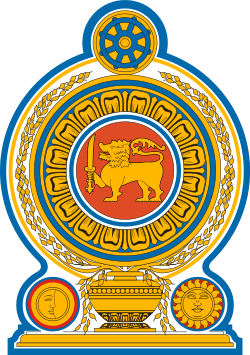D. S. Senanayake
| The Right Honourable D. S. Senanayake MP, PC | |
|---|---|
.jpg) D. S. Senanayake | |
| Prime Minister of Ceylon | |
|
In office 24 September 1947[1] – 22 March 1952[1] | |
| Monarch |
George VI Elizabeth II |
| Preceded by | Post created |
| Succeeded by | Dudley Senanayake |
| Leader of the House | |
|
In office 2 December 1942 – 4 July 1947 | |
| Preceded by | Don Baron Jayatilaka |
| Succeeded by | S. W. R. D. Bandaranaike |
| Minister of Agriculture and Lands | |
|
In office 1942–1947 | |
| Preceded by | Post created |
| Succeeded by | Dudley Senanayake |
| Member of the Ceylon Parliament for Mirigama | |
|
In office 14 October 1947 – 22 March 1952 | |
| Preceded by | Constituency Created |
| Succeeded by | John Edmund Amaratunga |
| Personal details | |
| Born |
20 October 1883 Botale, Mirigama, British Ceylon |
| Died |
22 March 1952 (aged 68) Colombo, Dominion of Ceylon |
| Nationality | Ceylonese |
| Political party | United National Party |
| Spouse(s) | Molly Dunuwila[2] |
| Religion | Buddhist |
Don Stephen Senanayake, PC (Sinhalese: දොන් ස්ටීවන් සේනානායක; 20 October 1883 – 22 March 1952) was the first Prime Minister of Sri Lanka. He emerged as the leader of the Sri Lankan independence movement that led to the establishment of self-rule in Sri Lanka. He served as Prime Minister from the formation of an independent nation in 1948 until he died in office in 1952. He is considered as the "Father of the Nation".[3]
Early life
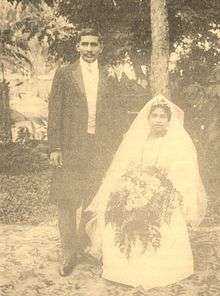
He was born in the village of Botale.[4] He was the son of Mudaliyar Don Spater Senanayake (1847–1907) and Dona Catherina Elizabeth Perera Gunasekera Senanayake (1852–1949). He had two brothers, Don Charles "D. C." Senanayake and Fredric Richard "F. R." Senanayake; and one sister, Maria Frances Senanayake.[3]
Brought up in a devout Buddhist family, he entered the prestigious Anglican school S. Thomas' College, Mutwal.[5][6][7][8][9][10]
After completing schooling, he worked as a clerk in the Surveyor General's Department, but left to work as a planter on his father's rubber plantation.[11]
Political career
Political activism
The three Senanayake brothers were involved in the temperance movement formed in 1912. When World War I broke out in 1914 they joined the Colombo Town Guard. The brothers were imprisoned without charges during the 1915 riots and faced the prospect of execution since the British Governor Sir Robert Chalmers considered the temperance movement as seditious. Brutal suppression of the riots by the British initiated the modern independence movement led by the educated middle class. Don Stephen and Don Charles were prominent members of the political party Lanka Mahajana Sabha. Fredrick Richard and Don Charles were committed supporters of the Young Men's Buddhist Association. D. S. Senanayake played an active role in the independence movement, initially in support of his brother Fredrick Richard.
Legislative Council
In 1924 Senanayake was elected unopposed to the Legislative Council of Ceylon from Negombo.[12][13] Fredrick Richard died on a pilgrimage to Buddha Gaya in 1925 and Don Stephen assumed his leadership of the independence movement.
State Council of Ceylon
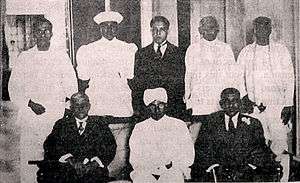
In 1931 he was elected to the newly formed State Council of Ceylon representing the Ceylon National Congress, and went on to become Minister of Agriculture and Lands.[14] He effectively combated Ceylon's agricultural problems and established the Land Development Ordinance, an agricultural policy to counter Ceylon's rice problems. This policy earned him respect, and he continued to be a minister for fifteen years, having been re-elected in 1936. He also enforced a productivity programme of "Agricultural Modernisation".
World War II
At the onset of World War II in the far east, on 1 December 1941 a Civil Defence Department was formed with Oliver Goonetilleke as Commissioner. D. S. Senanayake, as Minister of Agriculture and Lands and a member of the Ceylon war cabinet took an active role in food supply and control. A close relationship developed between Senanayake and the deputy commissioner Dr Ivor Jennings, principal of the Ceylon University College. Jennings, an expert on constitutional law, subsequently became D. S's adviser on constitutional reforms aimed at gaining independence for the island.[15]
Struggle for independence
In December 1942, Senanayake became the Leader of the House and Vice Chairman of the Board of Ministers in the State Council, upon the retirement of Sir Baron Jayatilaka, Minister of Home Affairs.[16] On 26 May 1943, the British Government made the Whitehall Declaration of 1943 on Ceylon constitutional change, which enabled ministers to make submissions.[14] This bypassed the Governor, who called for a commission from the colonial office to halt the activities of the ministers. Senanayake resigned from the National Congress disagreeing with its resolution on independence and instead approached the commission with his proposal of dominion status and they accepted the ministers' submissions, publishing these in the Sessional Paper XIV of 1944.[14][17] In 1944, the Soulbury Commission was formed. In 1945, following Labour's win in the 1945 general election, he proceeded to London and met the newly appointed Secretary of State for the Colonies, George Hall. Senanayake's submissions were accepted, resulting in self-government short of independence for Ceylon. He resigned his ministry in 1946 to push for full independence. That year he formed the United National Party (UNP) by amalgamating three right-leaning pro-Dominion parties.[15]
The granting of independence to India in 1947 and the appointment of Sir Arthur Creech-Jones as Colonial Secretary gave a new window for Senanayake to push for his case using the new constitution that was recommended by the Soulbury Commission. In the negotiations that followed, the British government accepted Senanayake's proposals for constitutional change and independence. parliamentary elections were held from 23 August – 20 September 1947. The "Independence Bill of Ceylon" was passed in December 1947. On 11 December 1947, Senanayake signed agreements with Britain including a defence pact that paved the way for independence of Ceylon. Senanayake's UNP fell short of a majority at the general election, but was able to form a government in coalition with the All Ceylon Tamil Congress and he became the Ceylon's first Prime Minister. On 4 February 1948, Ceylon marked its independence with a ceremonial opening of parliament.[15][18]
Premiership
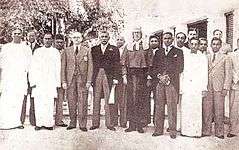
With his accession, Senanayake began the process of establishing institutions needed for an independent state. While most domestic institutions existed, Ceylon remained dependent on Britain for trade, defence and external affairs. He turned down a knighthood, but maintained good relations with Britain and was appointed to the Privy Council in 1950.[19] He boldly made plans to spread out the population, and his Gal Oya scheme relocated over 250,000 people. He held the Ministry of Defence and External Affairs, and also assumed that of Health and Local Government in 1951. He achieved membership of the Commonwealth, launch of the Colombo plan and the commencement of diplomatic relations with several other countries. Renovation of sites of historic importance in Anuradhapura and Polonnaruwa took place at this time.[20]

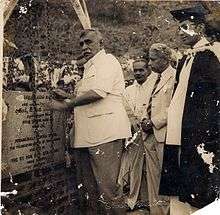
Death
Senanayake's proposals included expansion of hydro-electric power but, at the age of 68, he suffered a stroke and collapsed whilst riding at the Galle Face Green on the morning of 22 March 1952.[21]
Legacy
D. S. Senanayake is respected by Sinhalese and some Muslims. However, Tamils were not happy with his citizenship laws, which disenfranchised virtually all Tamils of recent Indian origin living in the central highlands. His bold agricultural plans and pro-Western policies drew criticism for their modern and untraditional nature. Under his family's leadership, Sri Lanka's economy flourished, and he is still known as "The Father of Sri Lanka".
Family
D. S. Senanayake married Molly Dunuwila, with whom he had two sons, Dudley Shelton Senanayake (19 June 1911 – 13 April 1973) and Robert Parakrama Senanayake (8 April 1913 – 26 April 1986). His eldest son, Dudley Shelton Senanayake, succeeded him as Prime Minister in 1952, followed by another relative, Sir John Kotelawala (1897–1980) in 1953, but this nine-year family dynasty was ended by a landslide victory for Solomon West Ridgeway Dias Bandaranaike in 1956, campaigning under the "Sinhala Only" slogan. Dudley Senanayake regained the Prime Ministership in 1960, and served again from 1965 to 1970. Rukman Senanayake, one of his grandsons, is a former cabinet minister, former chairman of the UNP, current member of parliament, and Assistant Leader of the UNP.
See also
References
- 1 2 Parliament of Sri Lanka - Handbook of Parliament, Prime Ministers Archived 25 March 2008 at the Wayback Machine.
- ↑ Sri Lankan Sinhalese Family Genealogy, The Don Bartholomews Senanayake Family Tree
- 1 2 D. S. Senanayake – The Father of the Nation
- ↑ Don Stephen Senanayake, the first Prime Minister of Sri Lanka by H. A. J. Hulugalle
- ↑ DS hobnobbed with the mighty but kept the common touch
- ↑ Don Stephen Senanayake
- ↑ D. S. Senanayake: A leader with extraordinary vision
- ↑ Don Stephen Senanayake, First Prime Minister of Sri Lanka
- ↑ The Sara Legend The launch of the autobiography of Manicasothy Saravanamuttu
- ↑ Remembering the 'Father of the Nation'
- ↑ D. S. Senanayake
- ↑ Don Stephen Senanayake, First Prime Minister of Sri Lanka by H. A. J. Hulugalle (The Island) Accessed 2015-11-08
- ↑ D. S. Senanayake: A leader with extraordinary vision by Walter Wijenayake (The Island) Accessed 2015-11-08
- 1 2 3 Rajasingham K. T. Sri Lanka: The Untold Story Asia Times, Ch. 10, 19 October 2001. Accessed 12 June 2015
- 1 2 3 'From 'half a loaf' to Independence
- ↑ What caused the rift between D.S. and Sir Baron by Drene Terana Sariffodeen (Sunday Times) Accessed 2015-11-08
- ↑ J.R. Jayewardene of Sri Lanka: 1906-1956 by By K. M. De Silva, William Howard Wriggins, p. 127-8 & 168-70 (Univ of Hawaii) ISBN 9780824811839
- ↑ Sinhalese Parties, Country Studies, Federal Research Division of the Library of Congress
- ↑ The London Gazette: no. 38797. p. 1. 30 December 1949.
- ↑ "D. S. SENANAYAKE A NATION'S FATHER and Undisputed Leader".
- ↑ In memory of their kindness
External links
- The Senanayake Ancestry
- The Senanayake Clan
- Remembering D S of Botale Walauwa
- Website of the Parliament of Sri Lanka
- United National Party website
- DS Senanayake in Sinhala
- Methek Kathawa Divaina
- Methek Kathawa Divaina
| Government offices | ||
|---|---|---|
| Preceded by – |
Prime Minister of Ceylon 1947–1952 |
Succeeded by Dudley Senanayake |
